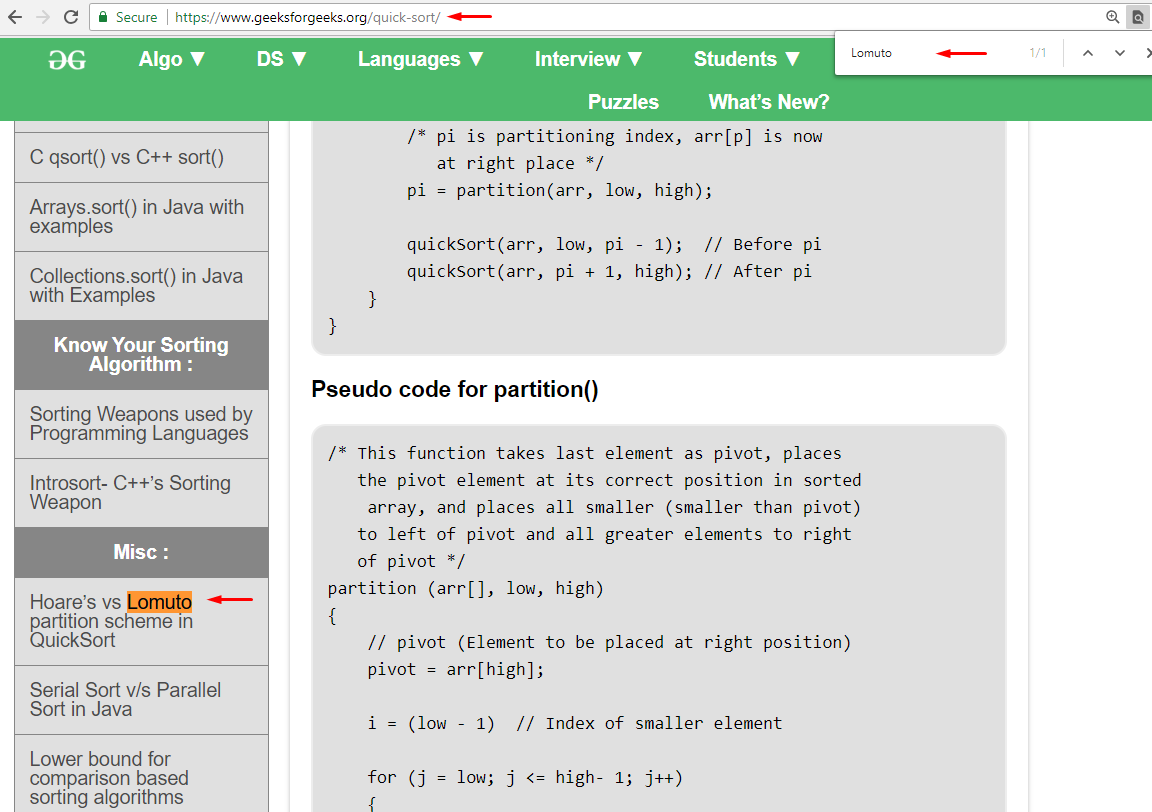QuickSort is actually two different algorithms (Lomuto and Hoare)
General observations
QuickSort is a Divide & Conquer sorting algorithm, which immediately hints how you should start implementing it:
public void QuickSort<T>(T[] items)
where T : IComparable<T>
{
QuickSort(items, 0, items.Length - 1);
}
private static void QuickSort<T>(T[] items, int low, int high)
where T : IComparable<T>
{
if (low < high)
{
// pi is for partition index;
// moves smaller or equal items to the left of the index pi
// and greater or equal to the right
int pi = Partition(items, low, high);
// recursively sort the two parts;
// that's why "Divide & Conquer"
QuickSort(items, low, pi);
QuickSort(items, pi + 1, high);
}
}
What’s left is to implement the Partition function which internally choses the pivot and moves smaller or equal (compared to pivot) items to the left of the returned index pi and greater or equal (compared to pivot) to the right of pi.
It turns out, that there are two commonly used types of such functions, which are more than different.
Those two are the Lomuto partition an the Hoare partition, which:
- have completely different performance – Hoare’s not only considers the degenerate case of a sorted array (subarray), but also makes ~3 times less swaps than Lomuto’s;
- have completely different code and looping – Hoare’s moves from two ends, Lomuto’s – form one end;
- Lomuto’s sets the
pivotitem to it’s final place in the initialitemsarray and returns its index, while as Hoare’s leavespivoteither in the left or the right part (i.e. either atpior atpi + 1), thus, it affects the recurringQuickSortfunction itself as it should either include or not include the item atpito the next recurring calls.
Confusion
So, are they usually referred to as two different algorithms of the same idea? Not necessarily. For example, the QuickSort article on GeeksForGeeks describes the algorithms using the Lomuto’s partition – apparently because it’s code is shorter – but the partition function isn’t explicitly called this way (except for the “miscellaneous” section).

The article is quite detailed and it even has mentions of possible QuickSort’s modifications, e.g. “3-Way QuickSort” and “Iterative Quick Sort”, but not how the classic recursive algorithm could use other partition function. And there’s also a dedicated article on the topic – but you have to know you need to search it first.
The confusion is also is also well-described in the answer by ggchappell, where he notes the following:
Fun fact: For many years, the Wikipedia article on Quicksort has had pseudocode for the Lomuto algorithm, and shown an animation of the Hoare algorithm, with no acknowledgement that these are different …
Algorithms’ code
So, the two QuickSort algorithms respective to the two partition functions are:
Lomuto’s
public void Sort<T>(T[] items)
where T : IComparable<T>
{
QuickSortLomuto(items, 0, items.Count - 1);
}
private static void QuickSortLomuto<T>(T[] items, int low, int high)
where T : IComparable<T>
{
if (low < high)
{
// if pi is partitioning index,
// items[pi] is now at the right place
int pi = PartitionLomuto(items, low, high);
// the current pivot element is in place (pi),
// thus, do not include it to further sorting
// recursive calls, the item at pi will not be moved further
QuickSortLomuto(items, low, pi - 1);
QuickSortLomuto(items, pi + 1, high);
}
}
private static int PartitionLomuto<T>(T[] items, int low, int high)
where T : IComparable<T>
{
T pivot = items[high];
// index of the end of the "smaller" list
int i = low - 1;
// index of the last item that has being checked
int j = low;
for (; j < high; ++j)
{
// If current element items[j]
// is smaller than or equal to pivot
if (items[j].CompareTo(pivot) <= 0)
{
++i;
// insert smaller (for ascending) element to the end
// of the "smaller" list - i.e. insert from j to i;
// here i <= j always
Swap(items, i, j);
}
}
// "i end" (ie) - index after the last index of the "smaller" list
int ie = i + 1;
// as i <= j < high, items[high] wasn't touched;
// therefore, here items[high] still holds the pivot value here
Swap(items, ie, high);
return ie;
}
private static void Swap<T>(T[] items, int i, int j)
{
T temp = items[i];
items[i] = items[j];
items[j] = temp;
}
Hoare’s
public void Sort<T>(T[] items)
where T : IComparable<T>
{
QuickSortHoare(items, 0, items.Count - 1);
}
private static void QuickSortHoare<T>(T[] items, int low, int high)
where T : IComparable<T>
{
if (low < high)
{
// if pi is partitioning index,
// items[pi] is smaller than or equal to the current pivot
int pi = PartitionHoare(items, low, high);
// Here the index of the pivot is either pi or pi + 1,
// thus could be moved later on;
// so, include both of those to further sorting
// recursive calls, items at pi and pi + 1 may be moved further on
QuickSortHoare(items, low, pi);
QuickSortHoare(items, pi + 1, high);
}
}
private static int PartitionHoare<T>(T[] items, int low, int high)
where T : IComparable<T>
{
// shouldn't necessarily be the first element
T pivot = items[low];
// index of the leftmost (thus il) element
// to be greater than or equal to pivot
int il = low - 1;
// index of the rightmost (thus ir) element
// to be smaller than or equal to pivot
int ir = high + 1;
while (true)
{
// find the leftmost element greater than or equal to pivot
// by skipping all the smaller ones by increasing il
// while items[il] < pivot (for ascending)
do il++;
while (items[il].CompareTo(pivot) < 0);
// find the rightmost element smaller than or equal to pivot
// by skipping all the greater ones by increasing ir
// while items[ir] > pivot (for ascending)
do ir--;
while (items[ir].CompareTo(pivot) > 0);
// if two indices met, return ir, that should be either
// the index of the pivot-value element or
// the index of the closest lower than the pivot element here
if (il >= ir)
return ir;
// else, if il and ir are not yet met, swap the respective items
Swap(items, il, ir);
}
}
private static void Swap<T>(T[] items, int i, int j)
{
T temp = items[i];
items[i] = items[j];
items[j] = temp;
}
Visual comparison
As you can see, the algorithms almost don’t have any common parts to be refactored out except for the Swap and Sort<T> functions that have little to no logic. Even the recurring QuickSortLomuto and QuickSortHoare functions (that are to represent the Divide & Conquer nature of QuickSort) were affected by the respective partition functions (by either including or not the element at the pi partition index to further sorting).
Execution time
The following unit tests measure the performance of the two algorithms:
[TestMethod]
public void Sorter_Quick_Lomuto_Test() =>
SorterTest(new QuickLomutoSorter());
[TestMethod]
public void Sorter_Quick_Hoare_Test() =>
SorterTest(new QuickHoareSorter());
public void SorterTest(ISorter sorter)
{
var largeInputPart =
Util.CreateArrayFromEnumerables(new[] { (1, 2), (2, 1), (3, 1) });
var scale = 400;
Func<int[]> getLargeInput =
() => Util.CreateArrayFromEnumerables((largeInputPart, scale));
Func<int[]> getLargeOutput =
() => Util.CreateArray((1, 2*scale), (2, scale), (3, scale));
var largeSameItemsInput = Util.CreateArray((5, scale));
var inputObjects = new[]
{
new {
Input = new[] { 1, 1, 3, 2, 9, 0 },
Output = new[] { 0, 1, 1, 2, 3, 9 }
},
new {
Input = new[] { 1, 2, 3, 4, 5 },
Output = new[] { 1, 2, 3, 4, 5 }
},
new {
Input = new[] { 0 },
Output = new[] { 0 }
},
// [1, 1, 2, 3, 1, 1, 2, 3, 1, 1, 2, 3, ...]
new {
Input = getLargeInput(),
Output = getLargeOutput()
},
// [1, 1, 1, 1, ... , 2, 2, ... , 3, 3, ...]
new {
Input = getLargeOutput(),
Output = getLargeOutput()
},
// [5, 5, 5, 5, ... ]
new
{
Input = largeSameItemsInput,
Output = largeSameItemsInput.ToArray()
},
};
foreach (var inputObject in inputObjects)
{
sorter.Sort(inputObject.Input);
// asserts collection elements equality
AssertUtil.AssertCollection(inputObject.Output, inputObject.Input);
}
}
The unit test has an unsorted input, input of small sorted chunks, sorted input, and input of the same elements.
And the results are:
Test Name: Sorter_Quick_Hoare_Test
Test Duration: 0:00:00.0030293
Test Name: Sorter_Quick_Lomuto_Test
Test Duration: 0:00:00.0507912
Therefore, here, Hoare’s version works ~17 times faster, than Lomuto’s. The results are also look as results of two completely different algorithms.
Subjectively
To me, the Hoare’s partition function looks much more intuitive. Imagine yourself as a thimblerigger - how would you move the cups in order to do it fast?

To me a sequence of exchanges of some left cup with some right cup while keeping a selected cup between them (whether it’s empty or not) seems natural (and that’s also how the actual “performers” do it), which is similar to Hoare’s method.
Steven-de-Rooij in his comment here also considers Hoare’s method not only faster, but also more intuitive:
I find the Hoare scheme the easiest to understand, and it is also the most efficient.
